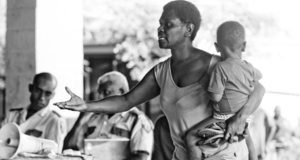Featured Article:Sociolinguistic Bias in AP Style: How News Media Deny African American Vernacular English Realities
By
2015, Vol. 7 No. 09 | pg. 4/4 | « 8. Foucauldian CounterargumentFiske subscribes to the Foucauldian view that varying ideologies compete to structure discourse (Foucault, 1977). He contends that all audience members have some independent interpretive agency: “The news is a montage of voices, many of them contradictory, and its narrative structure is not powerful enough to dictate always which voice to pay the most attention to, or which voice should be used as a framework by which to understand the rest” (304). This claim raises a significant issue for my thesis—audience members may be able to interpret a mainstream media text, regardless of their sociolinguistic backgrounds, as affirming their realities. It also highlights a fissure between content and interpretive analyses: How can all viewers of a production share in determining its meaning if its structure is biased? I posit that these positions need not be at odds. An abundance of media theory notes the tradition of marginalized social groups using interpretative techniques as psychological defense against media productions that delegitimize their realities (e.g., Stewart, 2005, 94-5, 107, 158 on “reconstructive spectatorship”). However, these interpretations do not negate the bias of the production. Indeed, that these interpretations are counterculture or non-normative suggests that the content of the media are structurally predisposed to relay reality for some groups, but not others. As I have argued in reference to Bourdieu, news media that follow AP style position AAVE viewers as the “other” through the organizational routines, lexical preferences, and syntactic restrictions that structure them to favor particular narratives and language communities over others. This sociolinguistic bias exists regardless of how AAVE speakers react to productions that follow AP style. Moreover, audiences’ subjective interpretation does not disprove the journalism industry’s institutional predilections for consistency, efficiency, and economic benefits, which sustain normative conceptions of national identity and normative power structures. 9. Conclusions and Suggestions for Further StudyMacdonald offers middle ground between critical content and interpretive analyses of news media representations: “Between…behaviourist accounts of media impact and Fiske’s utopian vision of active readers producing their own scripts…critical thinking about audience/text relations has tended to settle around the notion of ‘negotiation’ between text and reader…” (3). This paper has attempted to highlight language as a salient factor in this negotiation. AP style-directed news media promulgate subjective interpretations of reality that fulfill psychological needs for SAE speakers, but not AAVE speakers, whose language and worldview they delegitimize.As I have illustrated, the sociolinguistic bias of news media is evident in how AP style regulates lexicon and syntax, as well as how mainstream publications organize information and represent AAVE. News media’s bias towards SAE supports institutionalized discursive practices like the indexing of a golden rolodex of narratives, strategies of containment, and historical engineering, all of which foster symbiotic relationships between the journalism industry and state institutions. Accordingly, I have argued that AP style-directed news media support normative power dynamics by both reinforcing the dominance of SAE, as well as the journalism industry, political system, military, and legal system. While the viewer maintains interpretive agency, negotiation between her and the text ultimately takes place within the parameters of entrenched and unequal systems of power. The study of sociolinguistic bias in journalism yields a number of potential topics of further study that I was unable to address in this paper. First, the psychological effects of news media productions on viewers require further research. Macdonald notes that audiences constantly face the choice of identifying with a variety of often contradictory discourses, which promote particular realities. How much can audience members’ discretion mitigate the detrimental impacts of viewership? Second, the ways in which media translate AAVE texts into SAE relates to a larger discussion on the “politics of respectability” in contemporary African-American news media productions. How do modern media restrict expressions of Blackness? Finally, further cultural studies research on AAVE and language politics is necessary to better understand how language effects individuals’ interactions with state institutions. Appendix
Table 1: African-American and Mainstream News Media Segmentation1 ReferencesAnscombe, G. (1981). The First Person. In Metaphysics and the Philosophy of Mind (32). Minneapolis: University of Minnesota Press. Ash, S., & Myhill, J. (1986). Linguistic correlates of inter-ethnic contact. Diversity and Diachrony, 53 (33-44). Associated Press. (2015). A La Carte. Associated Press Stylebook Online. Retrieved from http://www.apstylebook.com/online/?do=entry&id=96&src=AE Associated Press. (2015). A La King. Associated Press Stylebook Online. Retrieved from http://www.apstylebook.com/online/?do=entry&id=97&src=AE Associated Press. (2015). A La Mode. Associated Press Stylebook Online. Retrieved from http://www.apstylebook.com/online/?do=entry&id=4925&src=AE Associated Press. (2015). Ain’t. Associated Press Stylebook Online. Retrieved from http://www.apstylebook.com/online/?do=entry&id=74&src=AE Associated Press. (2015). Al Dente. Associated Press Stylebook Online. Retrieved from http://www.apstylebook.com/online/?do=entry&id=4101&src=AE Associated Press. (2015). Al Fresco. Associated Press Stylebook Online. Retrieved from http://www.apstylebook.com/online/?do=entry&id=4102&src=AE Associated Press. (2015). Al Fresco. Associated Press Stylebook Online. Retrieved from http://www.apstylebook.com/online/?do=entry&id=3534&src=AE Associated Press. (2015). Baloney. Associated Press Stylebook Online. Retrieved from http://www.apstylebook.com/online/?do=entry&id=293&src=AE Associated Press. (2015). Colloquialisms. Associated Press Stylebook Online. Retrieved from https://www.apstylebook.com/online/?do=chapter Associated Press. (2015). Dialect. Associated Press Stylebook Online. Retrieved from https://www.apstylebook.com/online/?do=entry&id=856&src=AE Associated Press. (2015). Ho-hum. Associated Press Stylebook Online. Retrieved from http://www.apstylebook.com/online/?do=entry&id=1436&src=AE Associated Press. (2015). Hot Spot. Associated Press Stylebook Online. Retrieved from http://www.apstylebook.com/online/?do=entry&id=3977&src=AE Associated Press. (2015). That, Which (Pronouns). Associated Press Stylebook Online. Retrieved from http://www.apstylebook.com/online/?do=entry&id=2915&src=AE Associated Press. (2015). Who, Whom. Associated Press Stylebook Online. Retrieved from http://www.apstylebook.com/online/?do=entry&id=3201&src=AE Bailey, G., & Maynor, N. (1987). Decreolization?. Language in Society, 16(04) (449-473). Baker, L. (2000). Persons and Bodies: A Constitution View. Cambridge: Cambridge University Press. Bennett, L. (1988).News: The Politics of Illusion. New York: Longman. Bennett, L., R. Lawrence, and S. Livingston. (2007).When the Press Fails: Political Power and the News Media from Iraq to Katrina. Chicago: University of Chicago. Brundidge, S. (2010, November 30). Bristol Wins, Brandy Loses: A Modern-day Lesson for Black Folks. MSR Online. Retrieved from http://spokesman-recorder.com/bristol-wins-brandy-loses-a-modern-day-lesson-for-black-folks/ Brundidge, S. (2009, December 12). Sheletta Brundidge: At Last, Our Princess Has Come. Star Tribune. Retrieved from http://www.startribune.com/opinion/79092097.html Chomsky, N. (1986). All the News that Fits: Noam Chomsky on The New York Times. Utne Reader, 14 (Feb./Mar.) (56-65). Cotter, C. (2010).News Talk: Investigating the Language of Journalism. Cambridge: Cambridge University Press. “Current Members.” (2015). National Newspaper Publishers Association. Retrieved from: http://nnpa.org/memberships/current-members/ Fiske, J. (1987).Television Culture. London: Routledge. Foucault, M. (1977).Discipline and Punish. New York: Pantheon. Green, L. (2002). African American English: A Linguistic Introduction. Cambridge: Cambridge University Press. Hall, S. (1997).Representation: Cultural Representations and Signifying Practices. New York: Sage. Hamilton, P. (1997). Representing the Social: France and Frenchness in Post-War Humanist Photography. In S. Hall, J. Evans, S. Nixon (Eds.),Representation: Cultural Representations and Signifying Practices (75-150). New York: Sage. Hegel, Georg (1977). Phenomenology of Spirit, A. Miller (Trans.) 118-19. New York: Oxford University Press. Labov, W. (1998). Co-existent systems in African-American vernacular English. African-American English: Structure, History and Use (110-153). Labov, W., & Harris, W. (1986). De facto segregation of black and white vernaculars. Diversity and Diachrony, 53 (33-44). Lazzaro, E. (2015). I’m a stay-at-home mom who works sometimes. So what should my mom identity be? The Washington Post. Retrieved from: https://www.washingtonpost.com/posteverything/wp/2015/05/29/im-a-stay-at-home-mom-who-works-sometimes-so-what-should-my-mom-identity-be/ Macdonald, M. (2003). Exploring Media Discourse. London: Arnold. McChesney, R., & Nichols, J. (2010).The Death and Life of American Journalism: The Media Revolution That Will Begin the World Again. Philadelphia, PA: Nation. Montgomery, M., & Fuller, J. (1996). What was verbal-s in 19th-century African American English. Focus on the USA, 16 (211). Myhill, J., & Harris, W. (1986). The use of the verbal-s inflection in BEV. Diversity and Diachrony, 53 (25-32). Orgad, S. (2012).Media Representation and the Global Imagination. Cambridge: Polity. Poplack, S. (Ed.). (2000). The English History of African American English. Hoboken, NJ: Wiley-Blackwell. Shoemaker, S. (1968). Self-Reference and Self-Awareness. In Journal of Philosophy, 65 (555-67). New York: Columbia University Documentation Center. Sigal, L. (1973).Reporters and Officials: The Organization and Politics of Newsmaking. Lexington, MA: D. C. Heath. Stewart, J. (2005).Migrating to the Movies: Cinema and Black Urban Modernity. Berkeley: University of California. Swann, P. (2011). Self-Verification Theory. In P. Van Lange, A. Kruglanski, E. Higgins (Eds.), Handbook of Theories of Social Psychology: Volume Two (23-42). New York: Sage Publications. Taylor, C. (1992). To Follow a Rule.... In M. Hjort (Ed.) Rules and Conventions: Literature, Philosophy, Social Theory (167-85). Baltimore: Johns Hopkins University Press. “Top 25 U.S. Newspapers for March 2013.” (2015). Alliance for Audited Media. Retrieved from: http://auditedmedia.com/news/blog/top-25-us-newspapers-for-march-2013.aspx Vogt, N. “African-American Media: Fact Sheet.” (2015). Pew Research Center. Retrieved from: http://www.journalism.org/2015/04/29/african-american-media-fact-sheet/ Webster's New World College Dictionary, Fifth Edition. (2014). Boston: Houghton Mifflin Harcourt. Wittgenstein, L. (1958). The Blue and Brown Books (66f). Oxford: Oxford University Press. Endnotes1.) The table indicates with ‘X’ which of the categories listed that each newspaper represents on the homepage of their respective websites with either a main tab or dropdown menu tab. Some publications represent one or more categories multiple times. For example, The Washington Informer has both a “Lifestyle/Entertainment” tab and “Arts” dropdown menu tab, however the table only represents this category once in the “Arts & Entertainment” column. 2.) This category includes sections such as “Voices” (e.g., Chicago Defender), as well as only “Editorial” and “Opinion” sections. 3.) This category includes information about celebrities, as well as only “Entertainment” sections. 4.) This category includes information about local events, birthdays, people, and history. It represents sections that are explicitly labeled “Community,” as well as news sections that focus on a locality (e.g. Afro-American Newspapers’ “Prince George’s County News” section). 5.) This category includes “Spiritual” sections (e.g., The Dallas Weekly), “Faith & Family” (e.g., The Miami Times) and church activities. 6.) This category includes information about African-American icons and African-American history. It includes sections such as African American News & Issues’ “Manhood, Race & Culture.” 7.) This category includes sections such as Afro-American Newspapers’ “Government.” 8.) This category includes police reports and legal filings (e.g., Los Angeles Times’ “Homicide Report”). Suggested Reading from Inquiries Journal
Inquiries Journal provides undergraduate and graduate students around the world a platform for the wide dissemination of academic work over a range of core disciplines. Representing the work of students from hundreds of institutions around the globe, Inquiries Journal's large database of academic articles is completely free. Learn more | Blog | Submit Latest in Business & Communications |




















